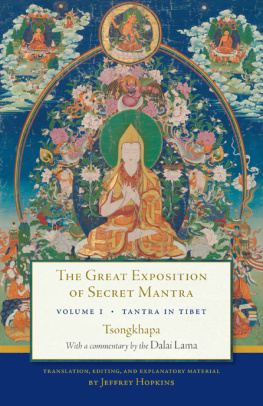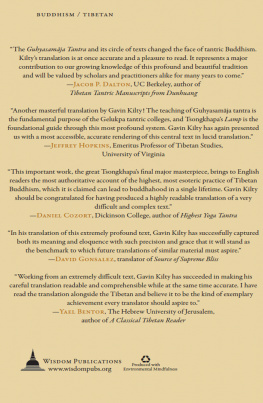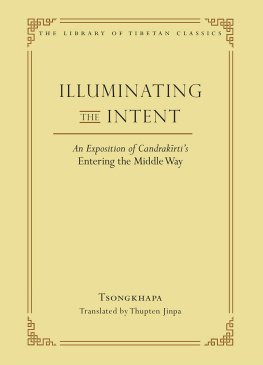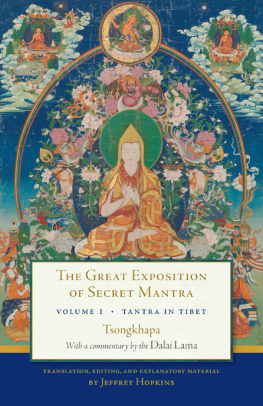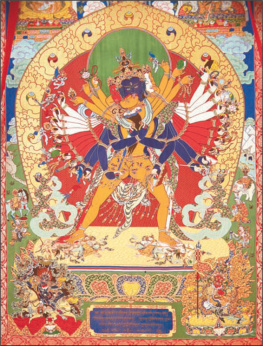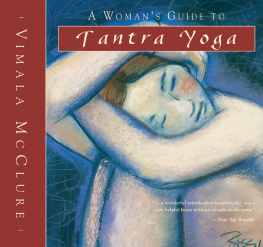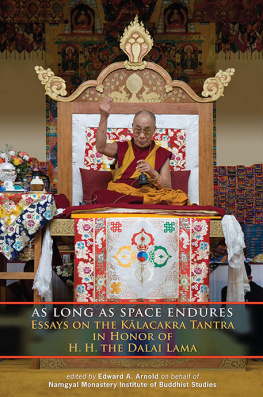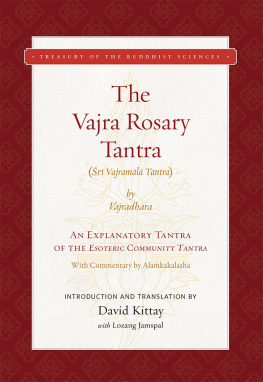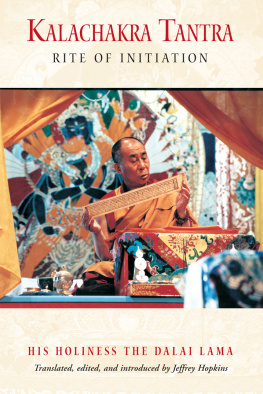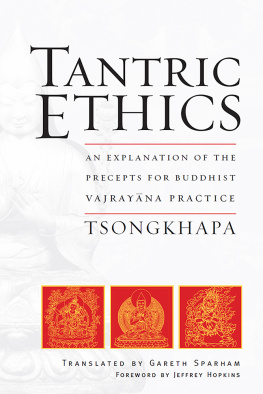Sign up to receive news and special offers from Shambhala Publications.

Or visit us online to sign up at shambhala.com/eshambhala.
The Great Exposition of Secret Mantra
VOLUME ONE
Tantra in Tibet
VOLUME TWO
Deity Yoga
VOLUME THREE
Yoga Tantra
The Great Exposition of Secret Mantra
VOLUME ONE

Tantra in Tibet
TSONGKHAPA
WITH A COMMENTARY BY THE
Dalai Lama
TRANSLATION, EDITING, AND EXPLANATORY MATERIAL BY
Jeffrey Hopkins
ASSOCIATE EDITOR FOR THE DALAI LAMAS TEXT AND TSONGKHAPAS TEXT
Lati Rinpoche
ASSOCIATE EDITOR FOR TSONGKHAPAS TEXT
Geshe Gedun Lodro

Snow Lion
An imprint of Shambhala Publications, Inc.
4720 Walnut Street
Boulder, Colorado 80301
www.shambhala.com
1977 by George Allen & Unwin Ltd.
Revisions to original edition 2016 by Jeffrey Hopkins
The book was first published by George Allen & Unwin Ltd., London, England, 1977, and previously published as Tantra in Tibet by arrangement with Unwin Hyman Ltd., 1987. The translation has been updated for the 2016 edition.
Cover design: Gopa & Ted2, Inc.
All rights reserved. No part of this book may be reproduced in any form or by any means, electronic or mechanical, including photocopying, recording, or by any information storage and retrieval system, without permission in writing from the publisher.
Library of Congress Cataloging-in-Publication Data
Names: Bstan-dzin-rgya-mtsho, Dalai Lama XIV, 1935 author. | Tsong-kha-pa Blo-bzanggrags-pa, 13571419, author. | Hopkins, Jeffrey, translator, editor.
Title: The Great Exposition of Secret Mantra / The Dalai Lama, Tsongkhapa; translated and edited by Jeffrey Hopkins.
Description: Boulder, Colorado: Snow Lion, 20162017. | Includes bibliographical references and index. Contents: volume 1. Tantra in Tibet volume 2. Deity Yoga volume 3. Yoga Tantra. | Includes translations from Tibetan.
Identifiers: LCCN 2016000757 | eISBN 9780834840591 | ISBN 9781611803594 (v. 1) | ISBN 9781611803587 (v. 2) | ISBN 9781611803600 (v. 3)
Subjects: LCSH: Tantric Buddhism. | Buddhist mantras. | BISAC: RELIGION / Buddhism / Tibetan. | RELIGION / Buddhism / Rituals & Practice.
Classification: LCC BQ7935.B774 G74 2016 | DDC 294.3/444dc23
LC record available at https://lccn.loc.gov/2016000757

This book contains diacritics and special characters. If you encounter difficulty displaying these characters, please set your e-reader device to publisher defaults (if available) or to an alternate font.

Homage to Vajradhara.
The Great Exposition of Secret Mantra by Tsongkhapa (13571419), founder of the Gelugpa order of Tibetan Buddhism, presents the main features of all the Buddhist tantra systems as well as the difference between stra and tantra, the two divisions of Buddhas word. Tsongkhapas text begins with an examination of the difference between the Buddhist vehicles, mainly analyzing a variety of earlier delineations of the difference between the Stra Great Vehicle and the Mantra Great Vehicle. Although Tsongkhapa does not mention Butn Rinchendrub as it is commonly called:
Tripiakamla and his commentator Vajrapifour differences
Jnashreleven differences
Ratnkarashntithree differences
Ngrjunasix differences
Indrabhutiseven differences
Jnapdathree differences
ombhiherukafive differences
Vajraghaapdafour differences
Samayavajrafive differences
deity yoga. His reason, in brief, is that method (compassion and the altruistic deeds it motivates) and wisdom are the central means of achieving the two Buddha Bodies, Truth Body and Form Bodies, and in deity yoga Mantra has a distinctive union of method and wisdom without which a Buddhas Form Bodies cannot be attained. This leads to Tsongkhapas conclusion that even through the Perfection Vehicle alone, Buddhahood cannot be attained.
The main points Tsongkhapa makes in distinguishing the Lesser Vehicle and the Great Vehicle and, within the latter, the Stra and Mantra Vehicles, are:
The difference between vehicles must lie in the sense of vehicle as that to which one progresses or as that by which one progresses.
The Lesser Vehicle differs from the Great Vehicle in both. The destination of the lower one is the state of a Hearer or Solitary Realizer Foe Destroyer and of the higher one, Buddhahood.
Concerning vehicle in the sense of means by which one progresses, although there is no difference in the wisdom realizing emptiness, there is a difference in methodLesser Vehicle not having and Great Vehicle having the altruistic intention to become enlightened and its attendant deeds.
Stra and Mantra Great Vehicle do not differ in terms of the goal, the state being sought, since both seek the highest enlightenment of a Buddha, but there is a difference in the means of progress, again not in wisdom but in method.
Within method, Stra and Mantra Great Vehicle differ not in the basis or motivation, the altruistic intention to become enlightened, nor in having the perfections as deeds, but in the additional technique of deity yoga. A deity is a supramundane being who himself or herself is a manifestation of compassion and wisdom. Thus, in the special practice of deity yoga one joins ones own body, speech, mind, and activities with the exalted body, speech, mind, and activities of a supramundane being, manifesting on the path a similitude of the state of the effect.
As scriptural authority for the central distinguishing feature between the Stra and Mantra Great Vehicles, Tsongkhapa quotes a passage from the Vajrapajara Tantra, rejects the commentaries of Khapda and Indrabodhi, and critically uses the commentary of Devakulamahmati, accepting some parts of that explanation and rejecting others. He reinforces his presentation of deity yoga as the dividing line between the two Great Vehicles with citations from or references to works on Highest Yoga Tantra by Jnapda, Ratnkarashnti, Abhaykra, Durjayachandra, Shrdhara, Samayavajra, Jinadatta, and Vinayadatta.
Despite Tsongkhapas many citations of tantras and Indian commentaries, it is clear that these are used only as supportive evidence for his presentation. Tradition is only supportive, not the ultimate authority. The arbiter is reason, specifically in the sense of determining coherence and consistency within a path structure. He refutes Ratnarakhita and Tripiakamla, for instance, not because they differ from the aforementioned sources but because their presentations fail in terms of consistency with the path structure. By doing so, he moves the basis of the exposition from scriptural citation to reasoned analysis of a meditative structure.
Also, whereas Butn catalogs nine ways that Indian scholaryogis differentiate the four tantra setsby way of the four Indian castes, four schools of tenets, four faces of Klachakra, four periods of the day, four eras, followers of four deities, four afflictive emotions to be abandoned, four levels of desire to be purified, and four levels of facultiesTsongkhapa critically examines most of these, accepting only the last two, with modification. He differentiates the four tantra sets by way of their main trainees being of four very different types, since these trainees have (1) four different ways of using desire for the attributes of the desire realm in the path and (2) four different levels of capacity for generating the emptiness and deity yogas that use desire in the path.
Next page
